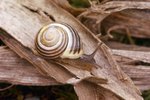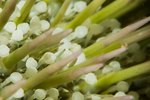
If you break coral (class Anthozoa) down to its simplest form, you get coral polyps, which are miniscule invertebrates that reside together in sizable colonies. Coral polyps are near kin to both sea anemones and jellyfish. They, along with algae, serve as the foundation of coral reefs, which are marine structures seen in shallow waters all around the globe.
Broad Size Range
Coral polyps run the gamut as far as size is concerned. Some individual specimens are less than 1 inch in diameter, while others have substantial diameters of more than 10 inches. Mushroom corals are a specific example of the latter. Coral polyps are fully capable of living solo, and polyps that reside in colonies usually aren't as big as those that live by themselves.
Body Outline
Coral polyps have shapes that are reminiscent of tubes. They are firmly planted to reefs with single sides of their bodies, while the other sides are equipped with mouths. Fleshy tentacles with stinging abilities are situated right by their mouths. They employ their tentacles both for transferring sustenance over to their mouths and for protecting themselves. Coral polyps' mouths lead to their stomachs. Since they lack anuses and intestines, they eliminate via their mouths. Other things they lack are blood, hearts, eyes, nervous systems and brains.
Coral Coloration
The tissues that make up coral polyps can bring upon a variety of colors, some of which include purple, blue, green, orange, red and yellow. Algae that inhabit these tissues often lead to coloration such as orange, green and brown.
Algae Residents
Miniscule plants all establish residence inside of coral polyps individually -- specifically algae. They work to give the polyps the essentials -- both nourishment and oxygen. Since the algae are living organisms, they require sunlight in order to develop and stay alive -- hence the establishment of reefs in shallow water environments.
Soft and Hard Corals
Coral exists in two distinct forms, both hard and soft. Hard corals are the ones that constitute reefs. They have internal limestone skeletons that are hard to the touch. The skeletons are referred to as calicles, and they function as coral reefs' main frameworks. These skeletons continue existing even after the polyps have passed away. Soft corals, on the other hand, are devoid of these skeletons. Soft corals differ from hard corals in that they have feather-like looks.
Power in Numbers
Although coral reefs are composed of some of the most basic and small creatures on the planet, they are actually visible from outer space -- a little evidence of the sheer power of numbers. When coral polyps park their bodies onto substrate such as stone, they often number in the millions. Some of their colonies are small, while others are immense. They occasionally can grow to between 10 and 13 feet tall.
References
- SeaWorld: Corals & Coral Reefs
- National Geographic Education: Coral Polyps
- National Geographic: Coral
- Stanford University Microdocs: What is a Coral?
- Australian Marine Environment Protection Association: Structure of a Coral Polyp
- Coral Reefs; Sriyanie Miththapala
- Coral Reefs; Katy Pike and Garda Turner
- ReefED: Soft Corals
Photo Credits
-
NASA/Photodisc/Getty Images




